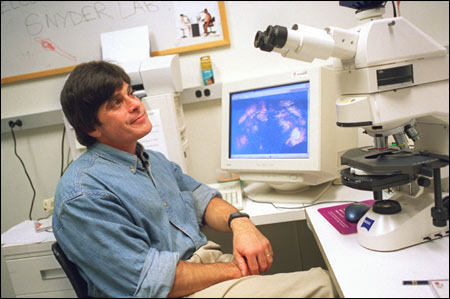Stem cells reduce brain damage:
May replace, protect injured tissue

Implants of stem cells have, for the first time, been used to replace and preserve missing and dying nerve cells in the brains of mice with human-like diseases. The research opens the way for a better understanding of how our brain develops and ages, and how stem cells might be used to treat injuries and diseases that happen along the way.
Mice with the kind of brain damage caused by strokes or cerebral palsy received implants of stem cells that resulted in the spontaneous replacement of many of the missing cells, according to Evan Snyder, a neurologist at the Harvard Medical School, who led the research. In other experiments, stem cells unexpectedly rescued the injured nerve cells of aged mice whose brains were compromised by the equivalent of Parkinson’s disease and normal aging in humans.
“If the experiments had been done in humans, it is difficult to know if we would have gotten the same results,” Snyder admits. “But I think there’s a possibility that stem cells might help re-form some of the lost connections between cells sufficiently to promote restoration of function.”
Snyder was surprised to see that stem cells not only replaced missing brain tissue, but provided protection for cells disabled by age and diseases like Parkinson’s and Alzheimer’s. “It’s not unreasonable to think that in humans the early implantation of stem cells – because of partnerships they form with host cells – might forestall or even pre-empt degenerative diseases such as Parkinson’s and Alzheimer’s,” Snyder says. “Perhaps, attacks by such diseases could be made less ferocious and mild enough for patients to adapt.”
These demonstrations of neural stem cells’ capacity to repair and protect a brain leads Snyder to speculate that other types of stem cells could perform the same functions in other organs, such as the heart, muscles, lungs, and liver. “Stem cells, in the broadest sense, are responsible for putting organs together in the womb,” he notes. “They are a normal part of development, so maybe we can find ways of fooling the injured or dysfunctional body into believing that development is still going on.”

Building a new brain
Earlier this year, Snyder, working with Yang (Ted) Teng of Harvard Medical School and Robert Langer of the Massachusetts Institute of Technology, used human stem cells to help repair spinal cord injuries in rats. They bridged breaks in the cord with stem cells placed on scaffolds made of a polymer similar to the dissolvable suture material used by surgeons to close wounds. The implanted stem cells, which can develop into many other cell types, replaced some of the spinal cord cells needed for movement, enabling the rats to regain some walking ability.
That success emboldened Teng, Snyder, and Kook In Park, a visiting Korean scientist, to attempt the same kind of experiments with mice whose brains were extensively damaged in much the same way as those of children and adults who suffer from cerebral palsy and stroke. Into spaces created by the damage, they implanted a scaffold full of neural stem cells, stem cells that had already begun the process of developing into brain cells.
Scaffolds held the stem cells in place near the damaged brain cells. “With the stem cells now fixed in space, we observed a rich complexity of ‘cross talk’ between the implanted cells and the injured brain,” Snyder relates. “They exchanged signals and built nerve-fiber connections to each other. Each changed the fate of the other in such a way that lost brain tissue gave the appearance of being reconstituted. Blood vessels even grew and the new brain tissue became nourished by the animal’s own brain.”
Tissue replacement appeared to be spontaneous. The researchers added no chemicals or genes to the stem cells or to the brain, and did not manipulate them in any way. The scaffolding degraded in about four-to-six weeks, and the mice seemed no worse for the experience. They had no seizures, no further brain damage, and went about doing what mice normally do.
How does this happen? “We don’t really know the details, though we have begun to identify some of the factors that might be involved,” Snyder replies. “These include molecules on the surface of the stem cells that can receive and send signals from and to the damaged brain.” These consist of molecules that encourage growth and participate in aspects of inflammation.
“It’s not unreasonable to think about doing this with humans someday,” Snyder believes. “However, before that happens we need to know immensely more about what the cells are doing. In the re-created parts of the brain, for example, are there undesirable as well as beneficial connections that could potentially make things worse.”
Slowing senility
The researchers describe their brain replacement successes in the November issue of Nature Biotechnology. In the same issue, another Snyder-led team reports on experiments to test whether neural stem cells might restore disabled cells in an aging brain.
Mice were treated with chemicals to trigger the slow loss of brain function typical of diseases such as Parkinson’s and Alzheimer’s, and similar to the normal process of aging. About 10 percent of the implanted cells spontaneously became new brain cells active in producing a chemical missing in people with afflictions like Parkinson’s. But, surprisingly, most of the stem cells became chaperones for endangered brain cells, preventing them from dying. “We could see areas of the brain whose function would have been lost to disease but whose nerve cells were now alive and active,” Snyder says.
“I should not have been surprised but I was,” he continues. “I have spent my entire career thinking about how stems cells can replace missing cells in the brain and other organs. I have spent years trying to get other people to view stem cells in this way. Now, we may be seeing a process even more powerful and effective than replacement – protection as a potent alternative or additional mechanism.”
Snyder credits his new view to Jitka and Vaclav Ourednik, postdoctoral fellows in his lab who did the experiments. “They were not surprised at all,” he comments. “They had seen this protective effect while working with transplanted tissue from fetuses. Fetal tissue, I have always believed, is chock-full of stem cells.”
The potential of this effect to slow down, even halt, the progression of degenerative diseases that ruin the lives of millions of older people is mind-boggling. Snyder and Teng (in collaboration with Robert Brown at Massachusetts General Hospital) have already begun using the protective approach to study its effects on mice suffering from a malady similar to amyotrophic lateral sclerosis (ALS). ALS, also called Lou Gehrig’s disease, is a progressive nerve-destroying ailment that affects breathing and movement and has no cure.
“We have obtained some compelling preliminary results,” Snyder says. “If we are successful, we might consider beginning experiments with some ALS patients within five years. We might also consider trying stem cell therapy on Parkinson’s patients within five years, if we can get enough basic understanding of the signals that pass between stem cells and damaged or dying nerve cells. We need to understand their language and listen in on what they are saying to each other before we can safely and effectively proceed towards trials with humans.”




